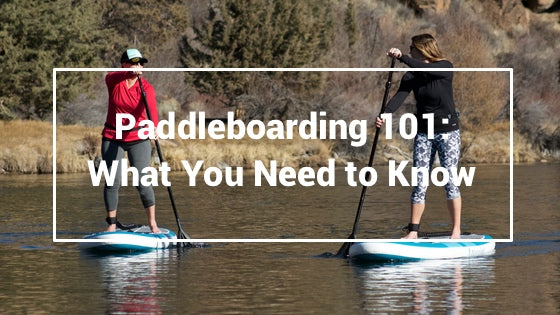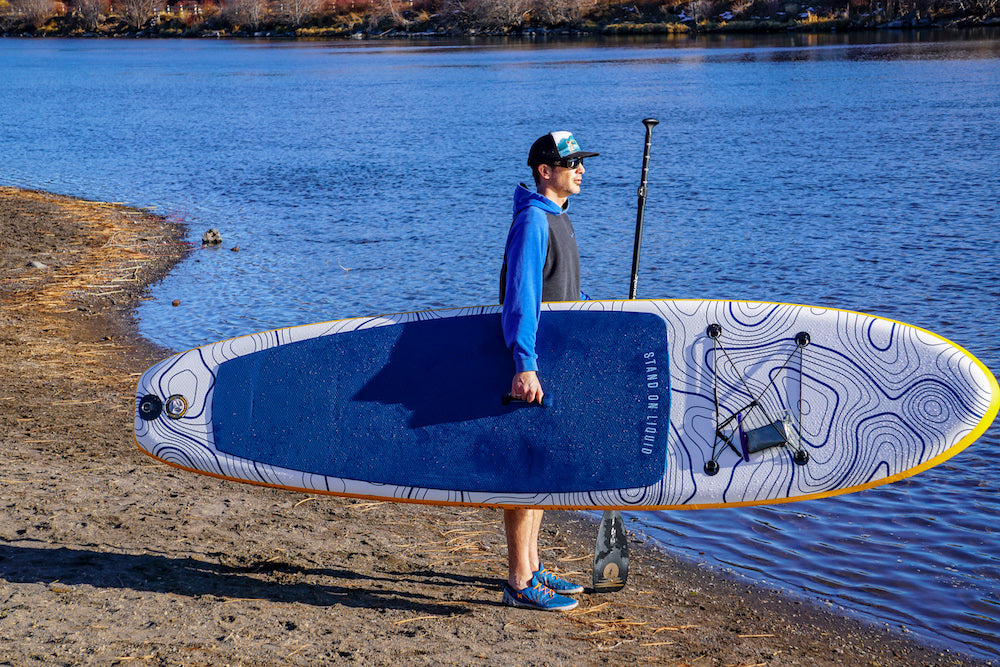By now you have probably seen a person or two partaking in stand up paddleboarding (aka SUP). This growing sport offers a fun, relaxing way to get fantastic exercise, unravel after a long day, and explore unknown waterways. With paddleboards being designed for nearly every type of activity, there's practically no end to what you can do. Whitewater river running, adventure touring, SUP yoga, fitness, racing, fishing, and family fun are just some of the opportunities that await you in the SUP world. With minimal investment, you too can enjoy hours on the water and share this fun sport with family and friends. Here are some basic tips and how to's to get you started.
The #1 Question: What Do I Need?
Luckily, paddleboarding requires very little gear to get started. And if you take care of your equipment correctly, it will last you through years of use.
The Board
Undeniably, the paddleboard is your most important piece of equipment and will be your biggest investment. The board you choose will depend greatly on the paddling activities you want to get into. For example, whitewater paddling will require a very different board than long-distance touring. Your board choice will also be influenced by your height, weight, and storage space. For an excellent guide to choosing the right SUP for you, check out this article.
The Paddle
SUP paddles will have a bend at the point the shaft connects to the blade providing increased power in your stroke. There are many different constructions from the aluminum price point paddles to the more expensive, lighter weight carbon paddles. Again, the type of paddling activity you choose will impact your paddle choice. Carbon paddles are extremely lightweight, making them great for long adventures where you want to reduce fatigue in your arms. Fiberglass paddles tend to be heavier than carbon but have greater flex, therefore reducing stress on joints over heavy use. Meanwhile, aluminum paddles offer durability at a nice, entry-level price for families that are hard on equipment or just looking for something fun to play around with. Paddles come in both fixed lengths or can be adjustable. The industry standard for paddle length is 10†taller than your physical height for recreational paddling and touring or 8†taller for whitewater and surfing. Adjustable paddles are a great idea for newer paddleboarders or those that want to share with friends and family.
A Leash
A very important safety feature, the leash, is used to keep you attached to your paddle board in case you fall into the water. The last thing you want on your paddleboarding adventure is to be stuck offshore and see your paddleboard drifting away. Not only will it put a major damper on your ride, but it can also quickly become dangerous. This video by SUP Magazine shows a great example of how important a leash is to your safety on the water.
The PFD (Personal Floatation Device)
Last, but far from least, you will need a PFD. Classified as a vessel by the US Coast Guard, paddleboards require that paddlers use PFDs, but more to the point, they're just plain important. Adding an extra layer of safety to your paddleboarding adventure, the PFD will keep you afloat in case of emergency. There are a number of US Coast Guard approved options that are specifically designed for paddleboarding. PFD belts are a great option; lightweight and low-profile, they keep your floatation device out of the way of your stroke but are ready in case they're needed.
Transporting Your Equipment Safely
The majority of damage to boards happens during transportation and storage, so knowing the best way to transport your paddleboard is key to increasing its longevity. One thing to note when carrying your SUP is to always pay attention to your surroundings. Paddleboards are generally between 10'-14' in length and that's a lot of space around you for the potential to bang into something!
Lifting Your Board
Since most SUPs will have a handle in the center of the board, to lift it just prop your board on its rail, get a firm grip on the handle, and lift, tucking it under your arm. Now you have a free hand to carry your paddle. If you're concerned about scratching your board when it's on its rail, consider getting rail tape. It won't affect the board's performance but it will add a little extra protection against rocks or cement.
Loading Your SUP onto a Vehicle
To load your paddleboard onto your vehicle you will need to lift it over your head to reach the roof. Try to find a soft, grassy spot and set your tail down with the deck of the board facing you. Grab a hold of the rails and move your hands up, stepping underneath the board until you're approximately in the middle between the nose and tail. Holding the rails firmly, lift the board upward, making sure to keep the weight evenly distributed so the nose and tail don't fall. Depending on the type of roof mounts you use, loading your board will be different. There are many different options, from attaching directly to crossbars, roof rack mounts, and even J-shaped racks that allow the boards to sit upright allowing for use next to bikes, car top carriers and other accessories. Keep in mind when loading your SUP, that the tail of the board should be at the front of the car and when lying on top of crossbars or horizontal racks, the deck of your SUP should face downward. Always secure your board with proper straps and locks when needed.
Caring for Your Paddle Board
The other side of the equation is what do you do with your paddleboard when it's not being used. The most important thing to keep in mind is to keep your paddleboard out of direct sunlight when it's out of the water. Leaving your board in the sun can cause a number of issues such as increased internal pressure, delaminating deck pads, bubbling in the epoxy, and other detrimental problems. Storing your board in a garage or basement which has regulated temperatures is best. Try to keep it off of the ground and away from anything that may fall onto the board. Unlike surfboards, paddleboards don't need waxing or yearly maintenance to maintain performance. However, it's a good practice to inspect your board routinely for scratches or dings that may need repair.



